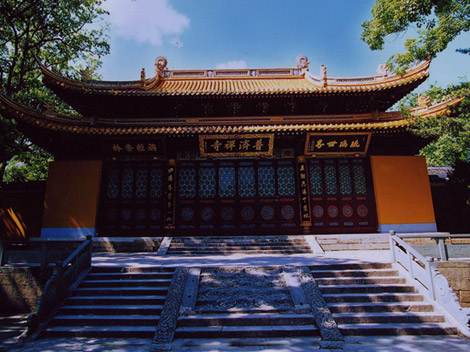Posted 2017/8/22
 Mount Putuo is a world renowned Guanyin worshipping site, and sacred land of Buddhism. The religious activities on the island started from Qin Dynasty (221BC-206BC). During Tang Dynasty, Mount Putuo prospered with the “Silk road over the sea”. In 863, a Japanese Monk named Huier left “Reluctant to go Guanyin” at Mount Putuo, and promoted Guanyin worshipping on the island. Mount Putuo gradually became the sacred home of Guanyin worshipping and a center of Chinese Buddhism. From here, Chinese Buddhism and Guanyin culture spreaded to Southeast Asia, Japan and Korea.
Mount Putuo is a world renowned Guanyin worshipping site, and sacred land of Buddhism. The religious activities on the island started from Qin Dynasty (221BC-206BC). During Tang Dynasty, Mount Putuo prospered with the “Silk road over the sea”. In 863, a Japanese Monk named Huier left “Reluctant to go Guanyin” at Mount Putuo, and promoted Guanyin worshipping on the island. Mount Putuo gradually became the sacred home of Guanyin worshipping and a center of Chinese Buddhism. From here, Chinese Buddhism and Guanyin culture spreaded to Southeast Asia, Japan and Korea.
By the end of Qing Dynasty (1644-1912), Mount Putuo had 3 grand temples, 88 smaller temples and 128 worship houses. They housed thousands of monks and nuns. A poet had said: “Every turn of the mountain road, there is a temple to see; every path one walks down, there is a monk to meet”. An inscription on Mount Putuo proclaimed: “China's number one Buddhist kingdom”. Such a status has attracted large amount of believers and worshipers, and it has been said that half of the Asians are the believers of Guanyin.
Guanyin worshiping started more than two thousand years ago on Mount Putuo. In 863, Japanese Monk Huier carried a Guanyin statue from Mount Wutai back to home en route Mount Putuo. His boat was stopped by a storm just out of Mount Putuo, and had to go on shore. Huier realized that it probably was Guanyin Buddha didn't want to go to Japan, so he built a worship house on Mount Putuo for the Guanyin statue, and named the statue "reluctant to go Guanyin". This solidified the association between Mount Putuo and Guanyin worshipping.
During Yuan Dynasty (1271-1368), there was already fair amount of Buddhist establishments on Mount Putuo, and gathered many respected monks. For example, the abbot of Puji Temple, Yi Shan Yi Ning, was sent by a Yuan emperor as an emissary to Japan. He helped repaire the relationship between China and Japan, which had been troubled for decades. Yi Shan also created his own branch of Buddhism (Yi Shan branch) in Japan, and was honored as a “Zen master” of Japan.
In the middle of Ming Dynasty (1368-1644), Mount Putuo was already the largest Guanyin worship site (Dojo) in east Asia, which was home of more than 200 large and small temples. It was not without twists during the development of this Buddhist pure land, however. During the early years of Ming Dynasty, pirates were on the rampage. They occupied mountains and robbed temples. The local army had fought the piracy fiercely on Mount Putuo. The emperor eventually ordered ban of sea travel. As a result, temples were burnt and monks were dismissed. In next 20 years, temple building were prohibited on Mount Putuo. Then abbot Zhenzai went to the capital to appeal for the rebuild of Mount Putuo, but passed away in the process. Emperor Shenzhong finally ordered the rebuild of Mount Putuo and sent entrusted official Zhangshui to monitor the construction, which lasted 5 years.
At the end of Ming Dynasty and beginning of Qing Dynasty, the history repeated itself, and the piracy once again caused destruction of Mount Putuo. In 14th year of Kangxi (1676), a large fire consumed major structures of the mountain. The imperial court once again ordered abandonment of Mount Putuo. 1690, abbot of Fayu Temple appealed to Emperor Kangxi for a rebuild and was approved. The imperial court twice sent large sum of money for the rebuild and the emperor even wrote name plaques for Fayu Temple. Mount Putuo once again prospered.
The latest rebuild of Mount Putuo started from 1979. Since then, billions of dollars have been invested on the island. Almost all temples have been renovated, and Buddhism is once again taking stronghold on this sacred land. On October 30, 1997, the Great Guanyin Statue was completed. The statue was 33 meters tall and cost more than 40 million Chinese Yuan. During the grand opening ceremony, when the abbot Jieren announced the start of celeration, a ray of sun shined through heavy clouds and on to the brass statue. The statue suddenly brightened up and reflected dazzling golden sunshine. The display lasted about 20 minutes and was widely regarded as Guanyin Buddha answering the prayer. The phenomenon was quickly spread among the Buddhist communities.
Since 2003, annual Guanyin cultural festival has been held. Every year, there is a new display of the positive influence of the Buddhism in the modern society. In 2006, Mount Putuo co-hosted for the first time the International Buddhism Forum, and it welcomed respected monks from dozens of countries and regions. Mount Putuo is right at the peak of its prosperity.